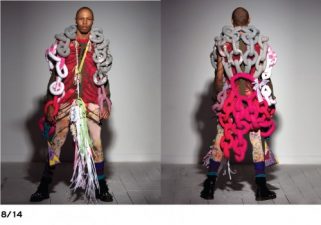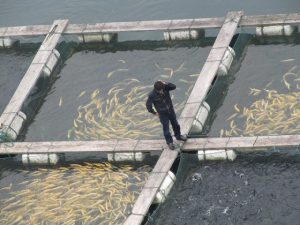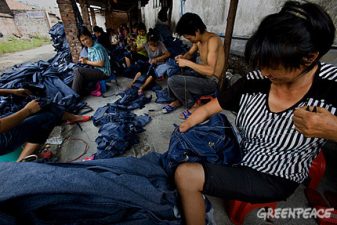 Leading fashion houses are turning to schools in search of new materials for high-end handbags, shoes, and accessories. We’re talking fish schools, as designers troll seafood industry waste streams looking for alternatives to increasingly banned exotic leathers. It’s not new, but it is trending. Is “leather” made from fish skin inventive recycling or another misstep for our master species?
Leading fashion houses are turning to schools in search of new materials for high-end handbags, shoes, and accessories. We’re talking fish schools, as designers troll seafood industry waste streams looking for alternatives to increasingly banned exotic leathers. It’s not new, but it is trending. Is “leather” made from fish skin inventive recycling or another misstep for our master species?
Big labels are exploiting the widely variable patterns, colors, and iridescence of fish skin (not found in traditional leathers) to bait buyers to new products. Many boutique designers already use it, and – as fish tend to be smaller than mammalian leather sources – their skins are ideally suited to crafting accessories. Fish leather is durable, flexible, and a differentiator in a competitive market. Icelandic company Atlantic Leather has made fish leather for two decades, supplying the material to brands like Prada, Dior, Nike, Ferragamo and Puma.
The sustainability angle is that widespread adoption of fish leather could relieve demand for cow leather, radically decreasing methane emissions. “Fish leather could also help create jobs in processing locations,” said Dr. Cecile Brugere, a research associate at the Stockholm Environment Institute. As example, Kenya’s Industrial Research and Development Institute and Danish development agency Danida are collaborating on a project to turn the country’s sizable fish skin waste into leather. But the case for using this waste-stream for fashion is a bit…fishy.
Start with a comparison of fish and mammal leathers, both by-products of the food industry. Since cows will continue to be raised on industrial scale regardless of consumer demand for suede shoes and leather handbags, emissions reductions are negligible. Prices are now comparable, but regular leather demand is rising faster than supply, and future price rises may be dramatic. Finally, as with regular leather, there is a commercial use for fish skin that goes beyond accessorizing: the manufacture of fish meal.
According to the World Bank, our increasing appetite for seafood has amped up production in capture fisheries to 93 million metric tonnes per year (up from 69 million in 1984). Production figures for aquaculture have grown to 63 million metric tonnes from 5 million in the same time span. With world population heading towards 11 billion by the end of this century, increased demand for efficient fish production means aquaculture will soon exceed traditional catch. A tonne of fish fillets typically nets 40 kg of skin waste. That’s a boatload of wallets. But which wins out – fish feedstock or fashion?
Farmed fish are dependent on fish meal, which is converted fish waste (trimmings, bones, fins and skin). An excellent source of protein, omega-3 fatty acids and essential vitamins and minerals, fish meal has been used as feed in Northern Europe since the 19th century and is now used worldwide. About 60% of all fish meal is used for aquaculture. Fish meal is also used to feed mammals – cattle, hogs and horses.
“There’s definitely a market for high-end fish leather products and it makes more financial sense to use fish skins in high-margin items like handbags than as fish meal,” said Brugere. “But with most fish skins already being used for fish meal, fish leather doesn’t solve a big waste problem.” Factor in the water-and-energy-intensive tanning process, and assertions of improved environmental impacts start to stink.
In the end, scent may be the deciding factor for the trend. “When I show my necklaces, the first thing that happens is that people walk up and smell them,” said Hanna Altmann, a Swedish designer who works with fish skin. “But once they’re familiar with the material, I only get positive reactions.” But she didn’t say what it smells like.
Image of a brown trout from Shutterstock



